Top 10 Most Famous Paintings in the World
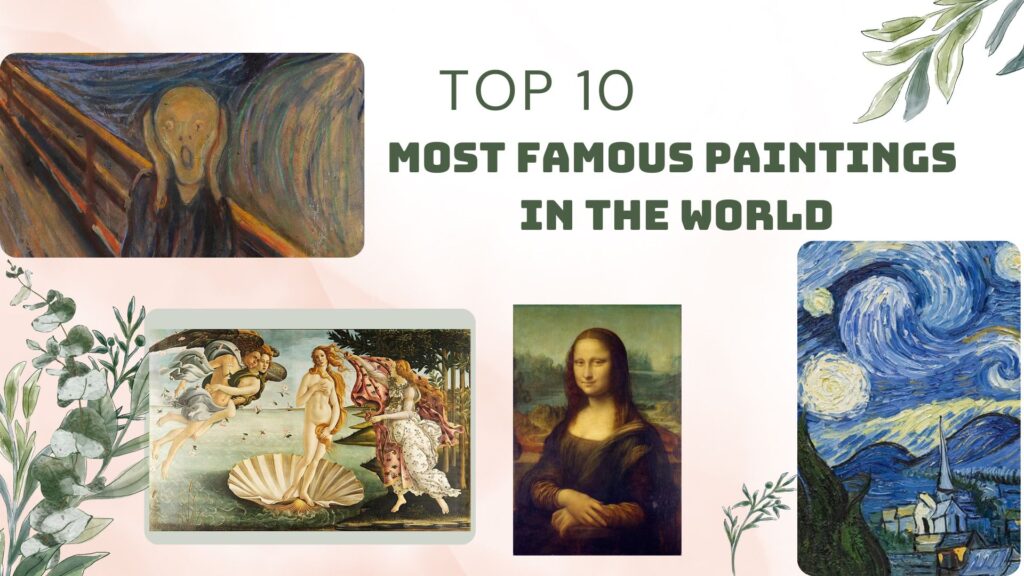
When it comes to art, we cannot overlook the realm of painting—a field that has shaped the culture and human history for millennia. Paintings are not merely artworks but also expressions of emotions, moods, thoughts, and the artist’s philosophy of life. They offer a glimpse into the past, providing a better understanding of the world and humanity through various epochs.
In this article, we will introduce you to the top 10 most famous paintings in the world. These are not just exceptional masterpieces but also unique and significant cultural icons that have contributed to the history of art worldwide.
These paintings were created by the most talented artists of humanity, from Leonardo da Vinci and Vincent Van Gogh to Pablo Picasso. They are not just paintings; they are artistic marvels that have profoundly influenced both culture and world history.
Throughout this exploration, we will delve into the origins, meanings, and impact of each painting, as well as the fascinating stories behind their creation. This promises to be an engaging and inspiring journey, helping us to better understand the value of art and the profound influence it holds over the world.
Let’s embark on this journey right now, starting with the most famous painting in the world:
1. Mona Lisa” by Leonardo da Vinci:

We begin our journey with one of the most widely recognized paintings in the world – Leonardo da Vinci’s “Mona Lisa.”
Leonardo da Vinci, an Italian artist, scientist, inventor, and philosopher, is one of the most versatile individuals in human history. He epitomizes the Renaissance era, a period in which humans emphasized the exploration and development of various fields of knowledge.
The “Mona Lisa,” also known as La Gioconda, is a masterpiece of art by Leonardo da Vinci. The painting was created between 1503 and 1506, and it might have continued until 1517. Currently, the artwork is exhibited at the Louvre Museum in Paris, France, attracting millions of visitors every year.
The “Mona Lisa” depicts a woman sitting with a mysterious and enigmatic smile, her gaze seemingly following the viewer. She wears a long, dark green robe with a high collar and cuffs of yellow, and behind her lies a hazy landscape with winding roads and distant mountains. What is particularly remarkable is the absence of any visible brushstrokes, creating an effect that is incredibly realistic and lifelike, as if Mona Lisa truly exists before our eyes.
The “Mona Lisa” has become an icon of art and culture. This painting reflects Leonardo da Vinci’s unique painting technique known as “sfumato,” which achieves a soft transition between tones, creating a natural and realistic image.
However, the painting is not only famous for its technical perfection but also for the mysterious smile of Mona Lisa. This smile has led to much speculation and theories. Some believe it represents a gentle happiness, while others interpret it as a sad or ironic smile. Whatever the truth may be, Mona Lisa’s smile has captivated and intrigued millions of people worldwide.
The “Mona Lisa” is not just an artistic masterpiece; it is a global cultural icon, a testament to the talent and creative vision of Leonardo da Vinci, one of the greatest artists in history.
2. “The Starry Night” by Vincent Van Gogh:

Continuing our journey, we come across another equally famous masterpiece – “The Starry Night” by Vincent Van Gogh.
Vincent Van Gogh, a Dutch artist, is renowned for his unique and powerful style of painting. Despite facing numerous tragedies and passing away at the young age of 37, Van Gogh created over 2,000 works of art, including oil paintings and colored drawings.
“The Starry Night,” created in 1889 while Van Gogh was staying at a mental hospital in Saint-Remy, France, is one of his most famous pieces. The painting is currently displayed at the Museum of Modern Art (MoMA) in New York.
The artwork portrays a nocturnal landscape with a star-filled sky over the village of Saint-Remy. The stars and a large moon above are depicted with strong, swirling brushstrokes, creating a sense of motion and energy. Below, there is a peaceful village with a tall church in the middle. Van Gogh utilized bold colors and strong lines to produce an effect of light and vibrant emotion in the painting.
“The Starry Night” is not just a painting; it is an expression of deep emotions and Van Gogh’s state of mind. Many art critics believe that this painting is evidence of his loneliness, anxiety, and desire for freedom. It also reflects the struggle between reality and dreams, light and darkness, joy and pessimism.
Through the combination of technique, color, and emotion, “The Starry Night” has become an exceptionally unique and captivating work of art. It touches the hearts of millions of admirers worldwide and leaves a profound mark in the history of art.
3. “The Last Supper” by Leonardo da Vinci:
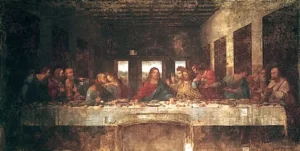
Our journey continues with another masterpiece by Leonardo da Vinci – “The Last Supper,” also known as “Bữa tối cuối cùng.”
“The Last Supper” is one of Leonardo da Vinci’s most famous works, painted between 1495 and 1498. It is a colossal wall painting located in the dining hall of the Convent of Santa Maria delle Grazie in Milan, Italy.
The painting depicts the final moments when Jesus shared a meal with his disciples before his arrest and crucifixion, a significant event in Christian scripture. In the center of the painting is the image of Jesus, surrounded by his disciples, each with a different expression upon hearing Jesus say that one of them will betray him.
What sets this painting apart is not only Leonardo da Vinci’s technique of using direct watercolor on fresh plaster to create vividness and realism for the characters but also his meticulous arrangement of the figures and attention to detail. Each character is portrayed with individual expressions, postures, and gestures, demonstrating personalized psychology and emotions.
“The Last Supper” has become a global cultural icon, showcasing the finesse and talent of Leonardo da Vinci. Interestingly, the painting also contains numerous mysteries and theories, such as the presence of Mary Magdalene or the positioning of Jesus and the disciples in a triangular shape, a symbol of the Holy Trinity.
“The Last Supper” is not just an artwork; it is a religious masterpiece, expressing spirituality and philosophical contemplation through the language of art. It is an indispensable work on the list of the world’s most famous paintings.
4. “Guernica” by Pablo Picasso:

We continue with a historically significant painting, the masterpiece “Guernica” by the legendary artist Pablo Picasso.
Pablo Picasso, a Spanish painter and sculptor, is one of the greatest artists of the 20th century. He is renowned for breaking traditional artistic norms to create his own style, known as Cubism.
“Guernica” is one of Picasso’s most famous works. The painting was created in 1937 as a response to the bombing of Guernica during the Spanish Civil War. Guernica, a small town in Northern Spain, was completely destroyed by a Nazi German air raid.
The painting “Guernica” depicts the horror and brutality of war through the use of symbolic imagery, such as anguished horses, reptiles on the ground, a mother holding her dead child, and a lightbulb on the wall. Picasso employed a palette of white, black, and gray to create a warm-toned painting, providing a backdrop of violence and chaos.
Although the painting uses only monochromatic colors, it evokes a powerful impact on the viewers. The shifting shapes, sizes, and imagery of the figures convey the chaos and desperation of war. “Guernica” not only portrays the horror of the air raid but also serves as a plea for peace in the world.
“Guernica” is currently displayed at the Reina Sofia Museum in Madrid, Spain, and has become one of the most potent symbols of the horrors of war. This painting not only exemplifies Picasso’s talent but also stands as a significant milestone in the history of art and humanity.
5. “The Scream” by Edvard Munch:

Next, we have a famous artwork called “The Scream,” also known as “Tiếng kêu,” by Norwegian artist Edvard Munch.
Edvard Munch was one of the prominent artists of the 19th and early 20th centuries, renowned for his expressive and deeply contemplative style in his artworks.
“The Scream” was first painted in 1893, and Munch created several different versions of it. The painting depicts a figure standing on a bridge across a lake, while the sky above transitions in colors from orange to vivid red. The figure clasps their hands to their face, and their mouth is wide open, forming an iconic representation of chaos, fear, and despair.
“The Scream” is considered an icon of human anxiety and distress in modern life. The painting not only depicts individual emotions but also reflects the author’s perspective on the harshness and pressures of contemporary existence. The tumultuous sky and the environment around the figure also symbolize societal unrest and threats.
“The Scream” has become one of the most famous artworks in history and has contributed to Edvard Munch’s reputation. This painting is not only regarded as a unique artwork but also as a cultural symbol, expressing the human soul and contemplations about life and the vast universe.
“The Scream” is displayed at the Munch Museum in Oslo, Norway, where visitors have the opportunity to delve deeper into the artwork and its impact on the world of art and culture.
6. “The Girl With A Pearl Earring” by Johannes Vermeer:
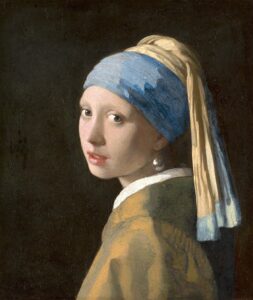
We continue our artistic journey with a marvelous and enigmatic painting – “The Girl With A Pearl Earring” by Dutch artist Johannes Vermeer.
Johannes Vermeer was a great painter of the 17th century, known for his realistic style and the subtle use of light in his works. Though not widely recognized during his lifetime, Vermeer became an iconic figure in Dutch and global art after his death.
“The Girl With A Pearl Earring,” also known as “Cô gái đeo vòng ngọc trai,” is one of Vermeer’s most famous works. The painting portrays a young girl wearing a pearl earring. She gazes directly at the viewer with an exquisite and captivating look, creating a sense of wonder and mystery in the painting.
“The Girl With A Pearl Earring” was painted around 1665 and is believed to be a portrait of a young woman named Griet. However, like many of Vermeer’s works, the painting is not merely a straightforward portrait but a symbolic artwork, expressing the enigma and psychological nuances of the character.
One of the special aspects of “The Girl With A Pearl Earring” is the use of bright colors and soft lighting, creating an effect that few artists could achieve. The light from the left side highlights the pearl earring and creates a radiant glow on the girl’s face, enhancing the beauty and mystique of the painting.
“The Girl With A Pearl Earring” has become an icon of art and culture, not only in Dutch art but also worldwide. The painting has inspired many artists and appeared in various cultural works, from films to books and songs.
Currently, “The Girl With A Pearl Earring” is displayed at the Mauritshuis Museum in the Netherlands and serves as an intriguing destination for art lovers and admirers of the refined beauty of oil paintings.
7. “The Birth of Venus” by Sandro Botticelli:
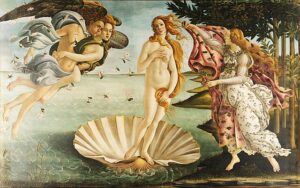
Continuing our artistic journey, we come to one of the most famous and beautiful works in the history of Italian art – “The Birth of Venus” by Sandro Botticelli.
Sandro Botticelli was one of the most talented artists of the Renaissance period and a student of legends such as Filippo Lippi and Verrocchio. He was renowned for his refined and skillful style in creating highly symbolic works of art.
“The Birth of Venus” is an oil painting on wood, created around 1484-1486. The painting depicts the scene of Venus – the goddess of love and beauty – emerging from the sea. She stands on a large seashell, holding a piece of cloth to cover her body. Meanwhile, a gentle spring breeze blows, creating a serene and pure atmosphere in the artwork.
“The Birth of Venus” beautifully showcases the artist’s personality. Botticelli used graceful and slender figures to create a stunning and captivating image. He painstakingly portrayed the beauty of the female form with delicate lines and vibrant colors, resulting in a mythological yet realistic masterpiece.
“The Birth of Venus” has become an icon of love, beauty, and femininity in art and culture. The painting is not only a work of art but also a cultural symbol, representing the beauty and significance of Renaissance art.
Currently, “The Birth of Venus” is displayed at the Uffizi Gallery in Florence, Italy. It is an enchanting destination for art enthusiasts who want to explore the exquisite beauty of this oil painting, a grand and glorious tribute to femininity and beauty.
8. “The Persistence of Memory” by Salvador Dalí:
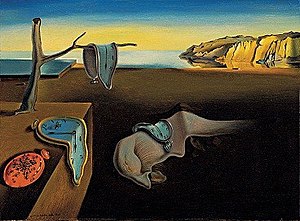
We continue our artistic journey with a famous painting full of mystery and surreal space – “The Persistence of Memory” by Salvador Dalí.
Salvador Dalí, one of the most famous and controversial artists of the 20th century, was a talented Spanish painter. He was known for his unique surrealistic style and ability to combine unusual elements in his works.
“The Persistence of Memory” is an oil painting, created in 1931. The painting depicts an unusual landscape with soft, melting clocks floating in space, while a house appears to be melting, and trees seem to dissolve. This landscape creates a dreamlike and unreal atmosphere, evoking a mesmerizing space full of contrasting emotions.
“The Persistence of Memory” has become an icon of Dalí’s surrealistic style and is one of the most famous works of art of the 20th century. It is considered a symbol of time, representing the passing and elusive nature of time.
One of the most notable features of “The Persistence of Memory” is the use of meticulous detail and delicate color blending. Sometimes, small details in the painting can be noticed only upon closer examination, creating a complex space with multiple meanings.
“The Persistence of Memory” has contributed to Salvador Dalí’s fame, making him one of the most famous and influential artists in art history. The painting has also played a role in the success of surrealism and remains an eternal icon of time and its passage.
Currently, “The Persistence of Memory” is displayed at the Museum of Modern Art (MoMA) in New York and is an exciting destination for art enthusiasts who want to explore the beauty and unique creativity of this oil painting.
9. The Creation of Adam” by Michelangelo:
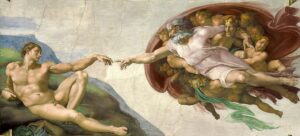
Continuing our artistic journey, we arrive at one of the most famous and beautiful works in art history – “The Creation of Adam” by Michelangelo.
Michelangelo Buonarroti, one of the greatest artists, sculptors, and architects of the Renaissance period, is renowned for his grand architectural works and magnificent oil paintings and frescoes such as “The Last Judgment” and “The Creation of Adam.”
“The Creation of Adam” is one of the frescoes on the main ceiling of the Sistine Chapel, located in the Vatican, Rome. The painting was created around the year 1512 and depicts the moment God the Father is creating Adam – the first human in the Bible and considered the ancestor of mankind.
“The Creation of Adam” is a symbolic and beautiful representation of creation and the power of spirit. The hands of God and Adam are almost touching, creating a remarkable moment that portrays the interaction between creation and humanity.
Michelangelo’s painting technique is one of the highlights of this fresco. He skillfully used light to illuminate the images of God and Adam against a dark background, creating brilliance and refinement in the painting. Though the painting uses simple colors, it produces a vibrant effect and showcases the unique style of the artist.
“The Creation of Adam” has become an eternal icon of creation and spirit in art and culture. This painting is not only a magnificent work of art but also a tribute to the essence of creativity and the power of humanity.
Currently, “The Creation of Adam” still adorns the ceiling of the Sistine Chapel and remains an enticing destination for art enthusiasts who wish to explore the beauty and profound meaning of this masterpiece.
10. Water Lilies” by Claude Monet:

Continuing our artistic journey, we encounter one of the most famous and beautiful art collections of the 20th century – “Water Lilies” by Claude Monet.
Claude Monet, one of the greatest and most influential artists of the Impressionist style in the 19th and early 20th centuries, is renowned for his exquisite depictions of natural landscapes and iconic works of art.
“Water Lilies” is a series of numerous oil paintings by Claude Monet, created from 1899 until his passing in 1926. This collection portrays images of water ponds within the garden at Giverny, where Monet lived throughout his life and created a renowned garden.
The “Water Lilies” paintings by Monet showcase his mastery in recreating the delicate details of water and water lilies on the pond’s surface. He uses soft brushstrokes and vibrant colors to create a dreamy and ethereal space.
The “Water Lilies” collection has become one of Claude Monet’s most famous and influential works of art. These paintings embody sophistication and contrast between light and shadow, providing a sense of relaxation and immersion in nature.
“Water Lilies” has contributed to the fame of Claude Monet, establishing him as one of the greatest and most influential artists in the history of art. This collection is also an icon of love and reverence for nature in art and culture.
Currently, many “Water Lilies” paintings by Claude Monet are displayed in various museums and art institutes worldwide, serving as enticing destinations for art enthusiasts who wish to explore the beauty and artistic brilliance of these works.
Free download wallpaper. Click here!
Tiktok ID: Omegasnap.net





